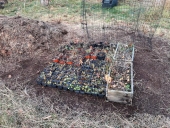
 7
7




"What I am Doing Tonight"?
Well, I'm setting the tone for the new year. It's not quite midnight. I need to melt snow for DW's houseplants and to keep my fish alive. But it bothers me to bring pails of snow inside -- that's another dollop of natural gas, and we burn more than I like already.
But: I noticed a free heat source. Our septic tank is right beside the house. I always cover the liquid side with plywood or something and bury with snow for insulation, because there's an anti-siphon loop close to the top and I don't want it to freeze. This year, even at -35C, I noticed there was enough heat coming off to melt holes in the snow I piled on.
So tonight, I took an old enamel canner full of ice and snow, added a litre of water for heat transfer, and set it on top of the septic tank lid. It was literally warm to the touch. Still, I had to cover it -- with a broken plastic tub that was headed for the dump eventually. And then I shovelled on a big pile of good old prairie fluffy snow for insulation.
Yes, I have pics, but this beater laptop can't pull them off my phone. Stay tuned. BTW I illuminated them with a Pelican headlamp that I recycled from the dump yesterday.
Top that, permie peeps! And a Happy New Year to you!
Jay Angler wrote:
My thoughts immediately went to, "I wonder if I could start seeds over ours... I'd need deer fencing..." Unfortunately, ours doesn't get the hours of sun that young plants would appreciate - but it might work for some people!Jane Mulberry wrote:Douglas, your creative use of the septic tank made me laugh till I teared up! Love it!
Douglas Alpenstock wrote:Mine is in full shade too, so no growing. But I may have found my spot for winter composting.
 3
3




 3
3




Gardens in my mind never need water
Castles in the air never have a wet basement
Well made buildings are fractal -- equally intelligent design at every level of detail.
Bright sparks remind others that they too can dance
What I am looking for is looking for me too!





I'm only 65! That's not to old to learn to be a permie, right?
 6
6




"You must be the change you want to see in the world." "First they ignore you, then they laugh at you, then they fight you, then you win." --Mahatma Gandhi
"Preach the Gospel always, and if necessary, use words." --Francis of Assisi.
"Family farms work when the whole family works the farm." -- Adam Klaus
 3
3




 2
2








Steve Zoma wrote:I always wondered why people with septic tanks did not do this? On a new tank, where they come in halves, right before putting them together, a coil could be inserted on the inside of it.
 9
9




![Filename: preparing-the-experiment.png
Description: [Thumbnail for preparing-the-experiment.png]](/t/207312/a/198715/preparing-the-experiment.png)
![Filename: old-tub-over-top.png
Description: [Thumbnail for old-tub-over-top.png]](/t/207312/a/198716/old-tub-over-top.png)
![Filename: snow-insulation-pile.png
Description: [Thumbnail for snow-insulation-pile.png]](/t/207312/a/198717/snow-insulation-pile.png)
![Filename: uncovering-the-tub.png
Description: [Thumbnail for uncovering-the-tub.png]](/t/207312/a/198718/uncovering-the-tub.png)
![Filename: meltwater-on-the-hob.png
Description: [Thumbnail for meltwater-on-the-hob.png]](/t/207312/a/198719/meltwater-on-the-hob.png)
 2
2




 5
5




 4
4




David Baillie wrote:I have seen people surround the sides of their tank and the top with foam to keep heat in. I would be worried that if you drew out too much heat you tank or bed would freeze. Not at the scale you are talking but if you tried to do the heat exchanger thing.
 7
7




Visit Redhawk's soil series: https://permies.com/wiki/redhawk-soil
How permies.com works: https://permies.com/wiki/34193/permies-works-links-threads
 5
5




Douglas Alpenstock wrote:
David Baillie wrote:I have seen people surround the sides of their tank and the top with foam to keep heat in. I would be worried that if you drew out too much heat you tank or bed would freeze. Not at the scale you are talking but if you tried to do the heat exchanger thing.
I think that's a valid concern, particularly for a septic field/bed in our cold climate. A freeze-up would be a royal PITA. My setup wouldn't be affected, but it's worth keeping in mind.
I'll stick to the lazy method of recapturing a little waste heat to solve the problem at hand.
 4
4




David Baillie wrote:I think you could totally scrape the surface of the tank and insulate everything except the two covers. You would create sort of water melting hotplates on your tank. Any loss of heat to melting would be made up by increased insulation on the rest of the tank and you would still have access to the covers for pump outs.

 3
3




Douglas Alpenstock wrote:
Steve Zoma wrote:I always wondered why people with septic tanks did not do this? On a new tank, where they come in halves, right before putting them together, a coil could be inserted on the inside of it.
All of them have top access, so a retrofit is possible. But it's a pretty low grade heat source. You'd need to use electricity to pump water down through the coil. On a residential scale, I'm not sure the net energy gain would be worth it.
A passive arrangement seems more viable to me.
 3
3




 6
6




 4
4




Douglas Alpenstock wrote:I've noticed that the working "high" level in my septic tanks is a lot lower than the maximum capacity -- less than 50%. I imagine that reduces the total recoverable heat by a fair bit.
I don't know if that setup is mandated somehow, but that's how the pro's do it. It certainly gives a wide safety margin in case of a pump failure or an extended power outage.

|
And then we all jump out and yell "surprise! we got you this tiny ad!"
The new gardening playing cards kickstarter is now live!
https://www.kickstarter.com/projects/paulwheaton/garden-cards
|








